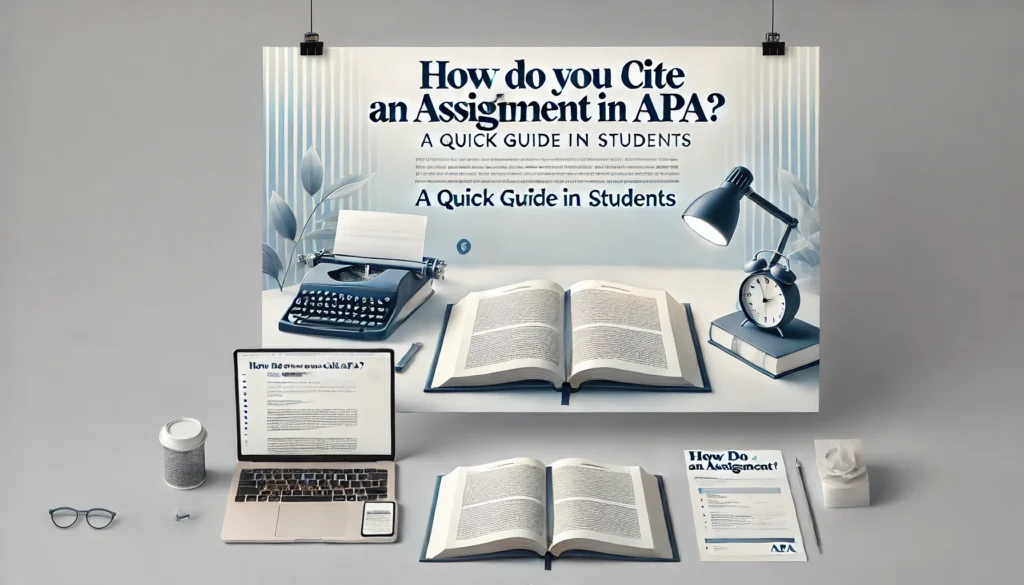How Do You Cite an Assignment in APA
As a student in Australia, mastering citation styles is an essential skill. The American Psychological Association (APA) format is widely used in academic writing, particularly in social sciences, business, and education. Properly citing your sources not only gives credit to the original authors but also strengthens the credibility of your work.
If you’ve ever wondered how to cite an assignment in APA, this comprehensive guide will walk you through the process step-by-step. By the end of this article, you’ll have all the knowledge you need to create accurate citations and references in APA format.

Understanding APA Style
APA style is a standardized format for academic documents such as research papers, essays, and reports. It emphasizes clarity, conciseness, and uniformity in presenting ideas. APA citations typically include two main components:
- In-text citations: These are brief references included within the body of your text.
- Reference list: A detailed list of all sources cited in your work, placed at the end of your document.
Key Elements of an APA Citation
An APA citation typically includes the following details:
- Author(s): The name(s) of the person or group responsible for the work.
- Year of Publication: When the source was published.
- Title: The name of the work (e.g., book, article, or assignment).
- Publisher/Source: The organization or platform where the work is published.
Citing an Assignment in APA
Assignments, such as essays or reports, fall into unpublished works. Here’s how you can cite them:
1. In-Text Citations for Assignments
APA in-text citations include the author’s last name, the year of submission, and the page or paragraph number if relevant.
Example:
- Paraphrase: (Smith, 2023)
- Direct Quote: (Smith, 2023, p. 5)
2. Reference List Entry for Assignments
The format for a reference list entry is slightly different from published works. It should include:
- Author(s).
- Year of submission in parentheses.
- Title of the assignment in italics.
- Indication that it is an unpublished manuscript.
- Institution name.
Template:
Author, A. A. (Year). Title of the assignment. Unpublished manuscript, Institution Name.
Example:
Smith, J. (2023). The impact of climate change on urban planning. Unpublished manuscript, University of Sydney.
Special Scenarios
Group Authors
If a group writes an assignment, list the group’s name as the author.
Example:
University of Melbourne, School of Psychology. (2023). Behavioral patterns in early childhood. Unpublished manuscript, University of Melbourne.
No Author
If no author is listed, start with the title of the assignment.
Example:
Analysis of Australian economic policies. (2023). Unpublished manuscript, Australian National University.
Multiple Authors
For assignments with multiple authors, list all names separated by commas, with an ampersand (&) before the last name.
Example:
Brown, A., Green, B., & Taylor, C. (2023). Sustainable agriculture practices in Australia. Unpublished manuscript, University of Queensland.
Formatting Your References List
Here are some tips for formatting your reference list:
- Alphabetical Order: Arrange entries alphabetically by the author’s last name.
- Hanging Indent: Indent the second and subsequent lines of each entry.
- Double Spacing: Use double spacing for the entire list.
Using APA Citation Tools
If you find APA formatting confusing, consider using online tools like:
- Citation Machine: Automatically generates citations in APA format.
- Purdue OWL APA Generator: A user-friendly tool for creating citations.
- Zotero or EndNote: Citation management software for complex projects.
These tools can save you time and help ensure accuracy.
Common Mistakes to Avoid
- Missing Information: Ensure all necessary details (e.g., author, year) are included.
- Improper Formatting: Double-check capitalization, italics, and punctuation.
- Incorrect Order: Follow APA’s specified order for citation components.
Why Proper Citation Matters
- Prevents Plagiarism: Avoids academic dishonesty by giving credit to original authors.
- Enhances Credibility: Demonstrates that your work is based on reliable sources.
- Meets Academic Standards: Shows your adherence to institutional guidelines.
Practical Tips for Students
- Keep a Citation Log: Maintain a list of sources as you research to avoid losing track.
- Use University Resources: Many universities offer workshops or guides on APA style.
- Practice Consistency: Apply APA rules uniformly throughout your work.
Final Thoughts
Citing an assignment in APA format might seem daunting at first, but with practice and attention to detail, it becomes second nature. By understanding the key components of APA citations and following the examples provided in this guide, you can ensure your assignments meet academic standards and showcase your professionalism.
For more academic writing tips and assignment assistance, visit OnlineAssignmentsHelp.com today. Our experts are here to help you succeed!



